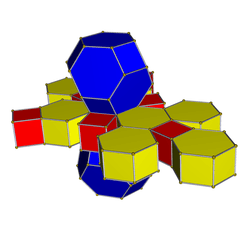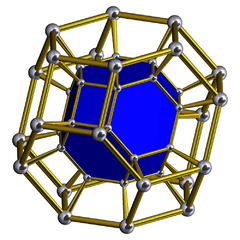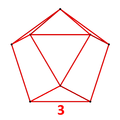Truncated octahedral prism
In 4-dimensional geometry, a truncated octahedral prism or omnitruncated tetrahedral prism is a convex uniform 4-polytope. This 4-polytope has 16 cells (2 truncated octahedra connected by 6 cubes, 8 hexagonal prisms.) It has 64 faces (48 squares and 16 hexagons), and 96 edges and 48 vertices.
| Truncated octahedral prism | |
|---|---|
| Type | Prismatic uniform 4-polytope |
| Uniform index | 54 |
| Schläfli symbol | t0,1,3{3,4,2} or t{3,4}×{} t0,1,2,3{3,3,2} or tr{3,3}×{} |
| Coxeter-Dynkin | |
| Cells | 16: 2 6 8 |
| Faces | 64: 48 {4} 16 {6} |
| Edges | 96 |
| Vertices | 48 |
| Vertex figure |  Isosceles-triangular pyramid |
| Symmetry group | [3,4,2], order 96 [3,3,2], order 48 |
| Dual polytope | Tetrakis hexahedral bipyramid |
| Properties | convex |
It has two symmetry constructions, one from the truncated octahedron, and one as an omnitruncation of the tetrahedron.
It is one of 18 uniform polyhedral prisms created by using uniform prisms to connect pairs of parallel Platonic solids and Archimedean solids.
Images
 Net |
 Schlegel diagram |
Alternative names
- Truncated octahedral dyadic prism (Norman W. Johnson)
- Truncated octahedral hyperprism
- Tope (Jonathan Bowers: for truncated octahedral prism)
Related polytopes
The snub tetrahedral prism (also called an icosahedral prism), ![]()
![]()
![]()
![]()
![]()
![]()
![]()
![]()
![]()
![]()
![]()
![]()
![]()
![]()
![]()
![]()
![]()
Also related, the full snub tetrahedral antiprism or omnisnub tetrahedral antiprism is defined as an alternation of an omnitruncated tetrahedral prism, represented by = ht0,1,2,3{3,3,2}, or ![]()
![]()
![]()
![]()
![]()
![]()
![]()
![]()
![]()
![]()
![]()
![]()
![]()
![]()
A construction exists with two regular icosahedra in snub positions with two edge lengths in a ratio of around 0.831 : 1.

Vertex figure for the omnisnub tetrahedral antiprism
See also
- Truncated 16-cell,







External links
- 6. Convex uniform prismatic polychora - Model 54, George Olshevsky.
- Klitzing, Richard. "4D uniform polytopes (polychora) x x3x3x - tope".